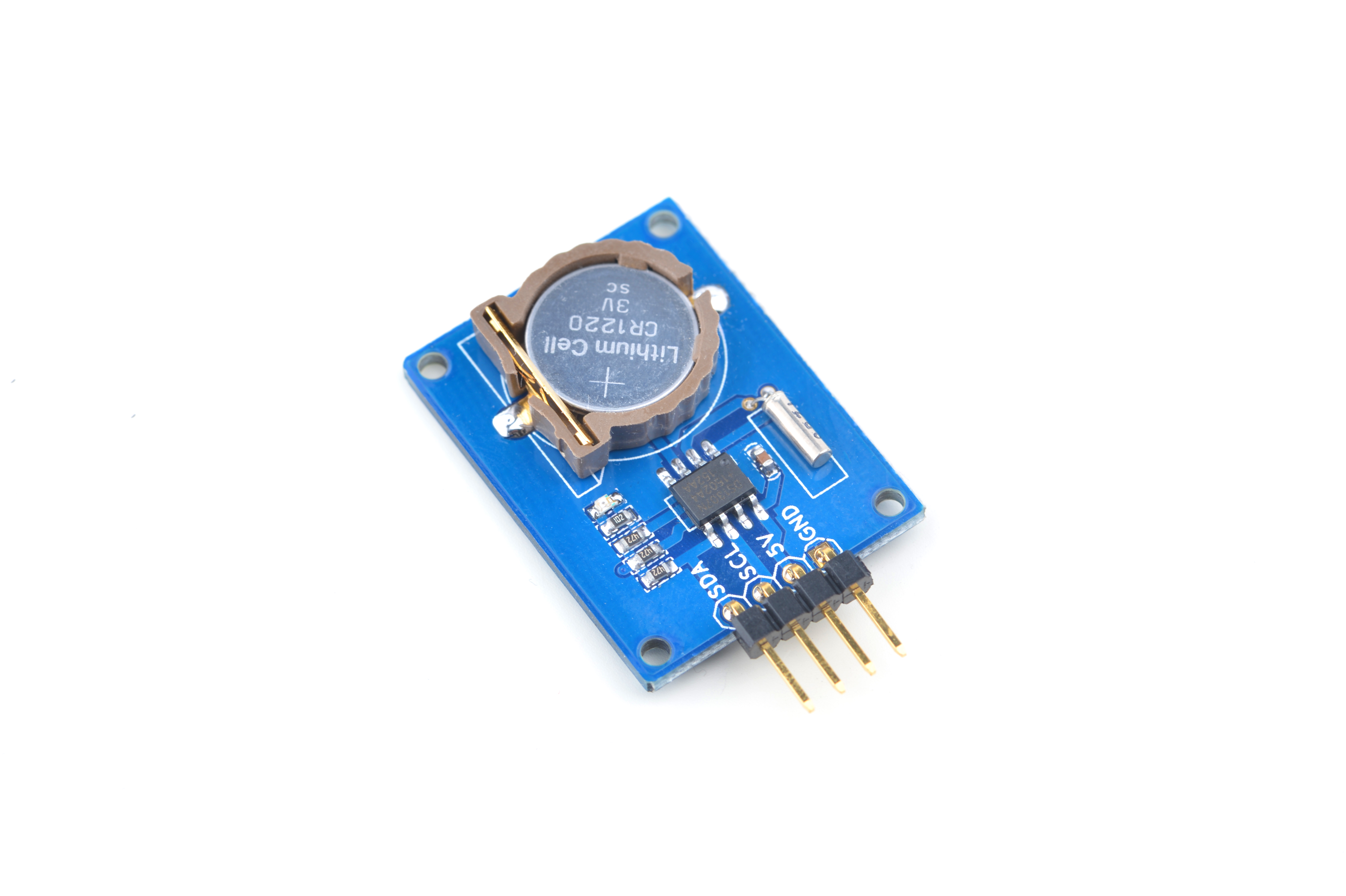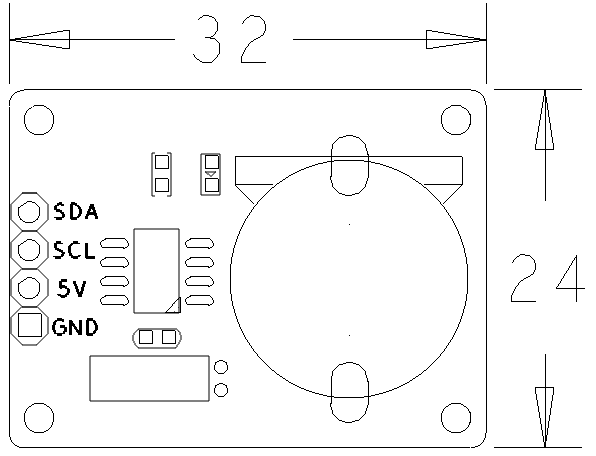Difference between revisions of "Matrix - RTC/zh"
(→工作原理) |
(→介绍) |
||
| Line 4: | Line 4: | ||
[[File:Matrix-RTC.png|thumb|]] | [[File:Matrix-RTC.png|thumb|]] | ||
*DS1307串行实时时钟是一种低功耗,完整的二进制编码的十进制(BCD)时钟/日历加56位字节的NV SRAM。地址和数据通过IIC串行传输,双向总线。 | *DS1307串行实时时钟是一种低功耗,完整的二进制编码的十进制(BCD)时钟/日历加56位字节的NV SRAM。地址和数据通过IIC串行传输,双向总线。 | ||
| − | *时钟/ | + | *时钟/日历提供秒、分、时、日、星期、月和年的信息。月的最后一天自动调整月的日数少于31天,包括闰年的修正。时钟运行24小时或者12小时格式与AM/PM指标。 |
| − | + | ||
==特性== | ==特性== | ||
Revision as of 06:07, 4 November 2015
Contents
1 介绍
- DS1307串行实时时钟是一种低功耗,完整的二进制编码的十进制(BCD)时钟/日历加56位字节的NV SRAM。地址和数据通过IIC串行传输,双向总线。
- 时钟/日历提供秒、分、时、日、星期、月和年的信息。月的最后一天自动调整月的日数少于31天,包括闰年的修正。时钟运行24小时或者12小时格式与AM/PM指标。
2 特性
- I2C串口接口
- 56字节、电池支持、通用的RAM和无限写道
- 8-Pin DIP和8-Pin SO
- 操作温度在-40度到85度
- PCB尺寸(mm):24x32
- 引脚说明:
| 名称 | 描述 |
| SDA | I2C SDA |
| SCL | I2C SCL |
| 5V | 电源5V |
| GND | 地 |
3 工作原理
- DS1307控制寄存器用来控制SQW/OWT引脚的操作:
- DS1307中的时间寄存器地址编码为00H-07H,而具有掉电保护的RAM寄存器的地址编码为08H-3FH。当地址指针指向RAM的最后一个地址3FH时,若进行多字节操作,则地址指针将会复位而指向00H,这样原来存在00H的数据将会丢失。
- DS1307的各类时间数据均以BCD码的格式存贮在
相应的时间寄存器中,具体分配为: 00H:秒;01H:分;02H:小时;03H:星期;04H: 日期;05H:月;06H:年;07H:控制字。
- DS1307支持I2C协议。设备发送数据到总线被定义为一个发射器和一个接收设备接收数据。DS1307的操作时序实际上就是I2C总线时序。
总线上传送的一帧数据为一个字节。
- 在对DS1307进行数据写入时,应先将日历时钟信息存放于单片机内部从45H开始的:8个RAM单元,而从DS1307读出的数据同样需存放在其中。
4 下载Matrix源码
Matrix配件相关的代码是完全开源的,统一由一个仓库进行管理:git://github.com/friendlyarm/matrix.git
该仓库里不同的分支代表着Matrix配件所支持的不同开发板。
- nanopi分支包含了Matrix对NanoPi的支持;
- tiny4412分支包含了Matrix对Tiny4412的支持;
- raspberrypi分支包含了Matrix对RaspberryPi的支持;
在主机PC上安装git,以Ubuntu14.04为例
$ sudo apt-get install git
克隆Matrix配件代码仓库
$ git clone git://github.com/friendlyarm/matrix.git
克隆完成后会得到一个matrix目录,里面存放着所有Matrix配件的代码。
5 与NanoPi连接使用
5.1 准备工作
在NanoPi上运行Debian系统,然后在主机PC上安装并使用相应的编译器。参考wiki:NanoPi
注意:必须使用nanopi-v4.1.y-matrix分支编译出来的内核。
下载NanoPi内核源代码并编译
$ git clone https://github.com/friendlyarm/linux-4.x.y.git $ cd linux-4.x.y $ git checkout nanopi-v4.1.y-matrix $ make nanopi_defconfig $ touch .scmversion $ make
5.2 硬件连接
参考下图连接模块Matrix-RTC和NanoPi
Matrix-RTC_nanopi
连接说明:
| Matrix-RTC_nanopi | NanoPi |
| SDA | Pin3 |
| SCL | Pin5 |
| 5V | Pin4 |
| GND | Pin6 |
5.3 编译测试程序
进入Matrix代码仓库,切换到nanopi分支
$ cd matrix $ git checkout nanopi
编译Matrix配件代码
$ make CROSS_COMPILE=arm-linux- clean $ make CROSS_COMPILE=arm-linux- $ make CROSS_COMPILE=arm-linux- install
注意:请确保你的主机PC当前使用的交叉编译器为NanoPi-Debian配套的arm-linux-gcc-4.4.3。
编译出来的库文件位于install/lib目录下,而测试程序则位于install/usr/bin目录下,模块Matrix-RTC对应的测试程序为matrix-rtc。
5.4 运行测试程序
拷贝库文件和测试程序到NanoPi的文件系统上
$ cp install/usr/bin/* nanopi_rootfs/usr/bin/ $ cp install/lib/* nanopi_rootfs/lib/ -d
然后启动NanoPi,在Debian的shell终端中执行以下命令加载驱动
$ modprobe rtc-ds1307运行模块Matrix-RTC的测试程序
注意:此模块并不支持热插拔,启动系统前需要确保硬件正常连接。
$ matrix-rtc5.5 代码展示
static const char default_rtc[] = "/dev/rtc0"; static const char default_date_time[] = "2015 9 15 1 1 1"; int main(int argc, char **argv) { int fd, retval; struct rtc_time rtc_tm; const char *rtc = default_rtc; const char *date_time = default_date_time; switch (argc) { case 3: rtc = argv[1]; date_time = argv[2]; break; case 1: break; default: fprintf(stderr, "usage: rtctest [rtcdev] [year mon day hour min sec]\n"); return 1; } fd = open(rtc, O_RDONLY); if (fd == -1) { perror(rtc); exit(errno); } fprintf(stderr, "RTC Driver Test Example.\n"); sscanf(date_time, "%d %d %d %d %d %d", &rtc_tm.tm_year, &rtc_tm.tm_mon, &rtc_tm.tm_mday, &rtc_tm.tm_hour, &rtc_tm.tm_min, &rtc_tm.tm_sec); rtc_tm.tm_year -= 1900; rtc_tm.tm_mon -= 1; retval = ioctl(fd, RTC_SET_TIME, &rtc_tm); if (retval == -1) { perror("RTC_SET_TIME ioctl"); exit(errno); } fprintf(stderr, "Set RTC date/time is %d-%d-%d, %02d:%02d:%02d.\n", rtc_tm.tm_mon + 1, rtc_tm.tm_mday, rtc_tm.tm_year + 1900, rtc_tm.tm_hour, rtc_tm.tm_min, rtc_tm.tm_sec); /* Read the RTC time/date */ retval = ioctl(fd, RTC_RD_TIME, &rtc_tm); if (retval == -1) { perror("RTC_RD_TIME ioctl"); exit(errno); } fprintf(stderr, "Read RTC date/time is %d-%d-%d, %02d:%02d:%02d.\n", rtc_tm.tm_mon + 1, rtc_tm.tm_mday, rtc_tm.tm_year + 1900, rtc_tm.tm_hour, rtc_tm.tm_min, rtc_tm.tm_sec); fprintf(stderr, "Test complete\n"); close(fd); return 0; }
6 与Tiny4412连接使用
6.1 准备工作
参考Tiny4412光盘里的《友善之臂Ubuntu使用手册》,在Tiny4412上运行UbuntuCore系统,然后在主机PC上安装并使用相应的编译器。
注意:只能使用Tiny4412SDK-1506的底板。
6.2 硬件连接
参考下图连接模块Matrix-RTC和Tiny4412
Matrix-RTC_tiny4412
连接说明:
| Matrix-RTC | Tiny4412 |
| SDA | CON18 SDA |
| SCL | CON18 SCL |
| 5V | CON18 5V |
| GND | CON18 GND |
6.3 编译测试程序
进入Matrix代码仓库,切换到tiny4412分支
$ cd matrix $ git checkout tiny4412
编译Matrix配件代码
$ make CROSS_COMPILE=arm-linux-gnueabihf- clean $ make CROSS_COMPILE=arm-linux-gnueabihf- $ make CROSS_COMPILE=arm-linux-gnueabihf- install
注意:请确保你的主机PC当前使用的交叉编译器为Tiny4412-UbuntuCore配套的arm-linux-gnueabihf-gcc-4.7.3。
编译出来的库文件位于install/lib目录下,而测试程序则位于install/usr/bin目录下,模块Matrix-RTC对应的测试程序为matrix-rtc。
6.4 运行测试程序
拷贝库文件和测试程序到Tiny4412的UbuntuCore的文件系统上
$ cp install/usr/bin/* tiny4412_rootfs/usr/bin/ $ cp install/lib/* tiny4412_rootfs/lib/ -d
然后启动Tiny4412,在UbuntuCore的shell终端中执行以下命令加载驱动
$ modprobe bmp085-i2c运行模块Matrix-RTC的测试程序
注意:此模块并不支持热插拔,启动系统前需要确保硬件正常连接。
$ matrix-rtc6.5 代码展示
static const char default_rtc[] = "/dev/rtc0"; static const char default_date_time[] = "2015 9 15 1 1 1"; int main(int argc, char **argv) { int fd, retval; struct rtc_time rtc_tm; const char *rtc = default_rtc; const char *date_time = default_date_time; switch (argc) { case 3: rtc = argv[1]; date_time = argv[2]; break; case 1: break; default: fprintf(stderr, "usage: rtctest [rtcdev] [year mon day hour min sec]\n"); return 1; } fd = open(rtc, O_RDONLY); if (fd == -1) { perror(rtc); exit(errno); } fprintf(stderr, "RTC Driver Test Example.\n"); sscanf(date_time, "%d %d %d %d %d %d", &rtc_tm.tm_year, &rtc_tm.tm_mon, &rtc_tm.tm_mday, &rtc_tm.tm_hour, &rtc_tm.tm_min, &rtc_tm.tm_sec); rtc_tm.tm_year -= 1900; rtc_tm.tm_mon -= 1; retval = ioctl(fd, RTC_SET_TIME, &rtc_tm); if (retval == -1) { perror("RTC_SET_TIME ioctl"); exit(errno); } fprintf(stderr, "Set RTC date/time is %d-%d-%d, %02d:%02d:%02d.\n", rtc_tm.tm_mon + 1, rtc_tm.tm_mday, rtc_tm.tm_year + 1900, rtc_tm.tm_hour, rtc_tm.tm_min, rtc_tm.tm_sec); /* Read the RTC time/date */ retval = ioctl(fd, RTC_RD_TIME, &rtc_tm); if (retval == -1) { perror("RTC_RD_TIME ioctl"); exit(errno); } fprintf(stderr, "Read RTC date/time is %d-%d-%d, %02d:%02d:%02d.\n", rtc_tm.tm_mon + 1, rtc_tm.tm_mday, rtc_tm.tm_year + 1900, rtc_tm.tm_hour, rtc_tm.tm_min, rtc_tm.tm_sec); fprintf(stderr, "Test complete\n"); close(fd); return 0; }

